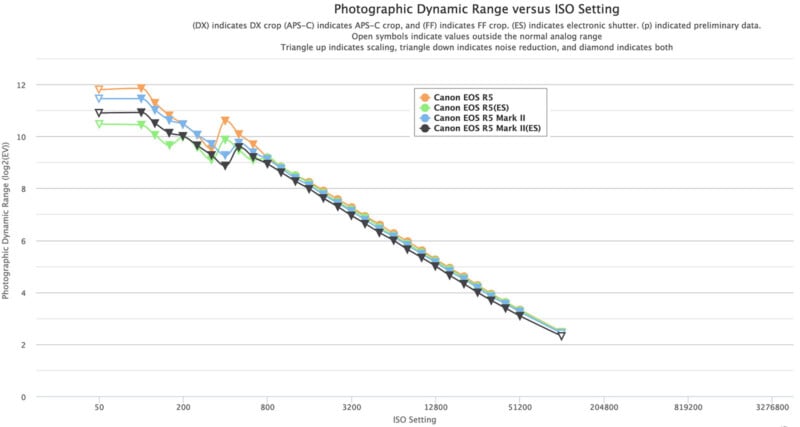The Canon EOS R5 II’s Dynamic Range Performance Is Complicated
![]()
Based on PetaPixel‘s hands-on with the Canon EOS R5 II and DPReview‘s studio test shots, it has already been made clear that the R5 II’s new stacked sensor comes with a dynamic range penalty. The complete picture has become clear with new Photons to Photos testing.
Keeping a general trend alive with stacked image sensors, the R5 II’s peak dynamic range doesn’t match that of its predecessor equipped with a standard, non-stacked image sensor. Per William Claff’s testing at Photons to Photos, the R5’s dynamic range peaked at 11.85 PDR, while the R5 II tops out at 11.45. That’s not a significant difference, but it is one nonetheless.

Even with this stacked sensor penalty in mind, the R5 II delivers a relatively impressive dynamic range for a full-frame camera. However, it does mean that there’s an image quality tradeoff for the R5 II’s remarkable speed and autofocus improvements.
This tradeoff is felt more acutely when the R5 II is used with its electronic shutter, required for the camera’s fastest shooting speeds. The R5 II’s peak dynamic range drops to 10.92 when using its electronic shutter.
While this doesn’t sound great, it’s worth contextualizing further. The EOS R5, while its peak dynamic range when using its mechanical shutter is superior to that of the R5 II, the original R5 suffers a massive penalty when using its electronic shutter. When using the electronic shutter, the R5’s peak dynamic range drops to a lowly 10.44 PDR.
When using its mechanical or electronic shutter, the R5 II still bests the new Nikon Z6 III and its partially-stacked image sensor, which tops out at 10.44 PDR. However, when it comes to the Nikon Z8, a primary competitor to the R5 II that features a fully-stacked image sensor, the situation changes. The Nikon Z8’s peak dynamic range is 11.31, so between the R5 II’s two shutter types. The Z8, like the Z9, doesn’t have a mechanical shutter at all.
The R5 versus R5 II image quality discussion essentially boils down to this: The R5 II offers a reduced dynamic range in an ideal situation compared to the R5 but offers better dynamic range when shooting at its fastest continuous shooting speeds. Further, the R5 II is itself quicker and more performant than the R5. The R5 II can shoot full-resolution images at up to 30 frames per second using its electronic shutter, while the R5 tops out at 20 FPS.
Many significant improvements in the Canon EOS R5 II make it superior to its predecessor for nearly every application. If the only downside is reduced dynamic range when using the mechanical shutter, many photographers will likely be happy to make the trade.
Image credits: Dynamic range test chart by Photons to Photos. Featured image created using an asset licensed via Depositphotos.